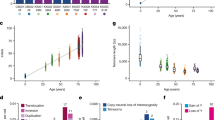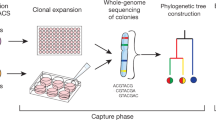Abstract
Female Safari cats are offspring of domestic and Geoffroy parents, and are balanced heterozygotes with equal numbers of Blood cells containing domestic and Geoffroy-type glucose 6-phosphate dehydrogenase (G6PD),an X-chromosome derived enzyme. In previous studies, however, we observed increasing percentages of Blood cells with Geoffroy G6PD in cats aged 4–12 years. Similarly, ratios of parental X-chromosome phenotypes greater than three to one are common in women over age 60, while women under 40 typically exhibit one to one ratios. Using a two-compartment hidden-Markov model of the distribution of phenotype in samples taken during the second stage of hematopoiesis (Blood cell production), we estimate, through simulation and mathematical calculation, the Geoffroy selective advantages necessary to reproduce the data obtained from female Safari cats. It is shown that small differences in the kinetics of hematopoietic stem cells (HSC), less than might be detected by in vitro assays, can explain the “clonal dominance” observed with aging in cats, and by extension, human females. Conceptually, hematopoiesis in females can be viewed as a competitive exclusion process in which two populations of HSC (defined by parental X-chromosome phenotype) compete for environmental resources. As in many ecological examples, dominance may occur only after long periods of time.
Similar content being viewed by others
References
Abkowitz, J. L., Catlin, S. N., and Guttorp, P. (1996), “Evidence That Hematopoiesis May Be a Stochastic Process in Vivo,” Nature Medicine, 2, 190–197.
Abkowitz, J. L., Catlin, S.N., McCallie, M. T., and Guttorp, P. (2002), “Evidence That the Number of Hematopoietic Stem Cells per Animal is Conserved in Mammals,” Blood, 100, 2665–2667.
Abkowitz, J. L., Linenberger, M., Newton, M. A., Shelton, G. H., Ott, R. L., and Guttorp, P. (1990), “Evidence for Maintenance of Hematopoiesis in a Large Animal by the Sequential Activation of Stem Cell Clones,” in Proceedings of the National Academy of Science, 87, pp. 9062–9066.
Abkowitz, J. L., Taboada, M., Shelton, G. H., Catlin, S. N., Guttorp, P., and Kiklevich, J. V. (1998), “An XChromosome Gene Regulates Hematopoietic Stem Cell Kinetics,” in Proceedings of the National Academy of Science, 95, pp. 3862–3866.
Bailey, N. (1964), The Elements of Stochastic Processes With Applications to the Natural Sciences, New York: Wiley.
— (1968), “Stochastic Birth, Death and Migration Processes for Spatially Distributed Populations,” Biometrika, 55, 189–198.
Boggs, D. R. (1985), “Mass and Distribution of Erythroid Marrow in Aged Mice,” Experimental Hematology, 13, 1044–1047.
Busque, L., Mio, R., Mattioli, J., Brais, E., Brais, N., Lalonde, Y., Maragh, M., and Gilliland, D. G. (1996), “Nonrandom X-Inactivation Patterns in Normal Females: Lyonization Ratios Vary with Age,” Blood, 88, 59–65.
Catlin, S. N. (1997), “Statistical Inference for Partially Observed Markov Population Processes,” unpublished Ph.D. dissertation, University of Washington, Dept. of Statistics.
Catlin, S. N., Abkowitz, J. L., and Guttorp, P. (2001), “Statistical Inference in a Two-Compartment Model for Hematopoiesis,” Biometrics, 57, 546–553.
Champion, K. M., Gilbert, J. G. R., Asimakopoulos, F. A., Hinshelwood, S., and Green, A. R. (1997), “Clonal Haematpoiesis in Normal Elderly Women: Implications for the Myeloproliferative Disorders and Myelodysplastic Syndromes,” British Journal of Haematology, 97, 920–926.
Cox, D. R., and Miller, H. D. (1965), The Theory of Stochastic Processes, London: Methuen.
Elton, C. S. (1927), “Animal Ecology,” London: Sidgwick & Jackson.
Gale, R. E., Fielding, A. K., Harrison, C. N., and Linch, D. C. (1997), “Acquired Skewing of X-Chromosome Inactivation Patterns in Myeloid Cells of the Elderly Suggests Stochastic Clonal Loss with Age,” British Journal of Haematology, 98, 512–519.
Gause, G. F. (1932), “Experimental Studies on the Struggle for Existence. I. Mixed Population of Two Species of Yeast,” Journal of Experimental Biology, 9, 389–402.
Knuth, D. E. (1968), The Art of Computer Programming, Volume 1, Reading: Addison Wesley.
MacArthur, R. H., and Wilson, E. O. (1967), The Theory of Island Biogeography, Princeton: University Press.
Puri, P. S. (1968), “Interconnected Birth and Death Processes,” Journal of Applied Probability, 5, 334–349.
Renshaw, E. (1972), “Birth, Death, and Migration Processes,” Biometrika, 59, 49–60.
Rufer, N., Brümmendorf, T. H., Kolvraa, S., Bischoff, C., Christensen, K., Wadsworth, L., Schulzer, M., and Lansdorp, P.M. (1999), “Telomere Fluorescence Measurements in Granulocytes and T Lymphocyte Subsets Point to a High Turnover of Hematopoietic Stem Cells and Memory T Cells in Early Childhood,” Journal of Experimental Medicine, 190, 157–167.
Stewart, F.M., Zhong, S., Wuu, J., Hsieh, C., Nilsson, S. K. and Quesenberry, P. J. (1998), “Lymphohematopoietic Engraftment in Minimally Myeloablated Hosts,” Blood, 91, 3681–3687.
Zeichner, S. L., Palumbo, P., Feng, Y. R., Xiao, X., Gee, D., Sleasman, J., Goodenow, M., Biggar, R., and Dimitrov, D. (1999), “Rapid Telomere Shortening in Children,” Blood, 93, 2824–2830.
Author information
Authors and Affiliations
Corresponding author
Rights and permissions
About this article
Cite this article
Catlin, S.N., Guttorp, P., McCallie, M.T. et al. Hematopoiesis as a competitive exclusion process: Estimation of a stem cell selective advantage. JABES 9, 216–235 (2004). https://doi.org/10.1198/1085711043550
Received:
Revised:
Issue Date:
DOI: https://doi.org/10.1198/1085711043550




